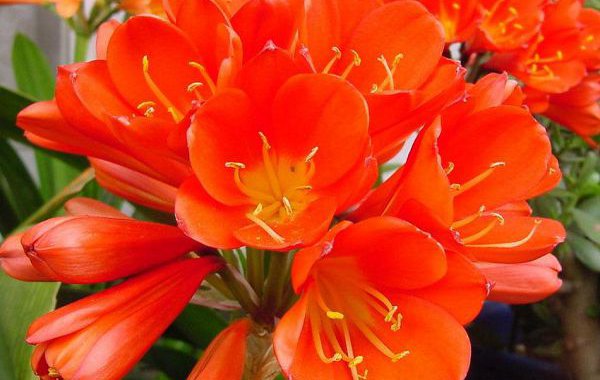How to raise a gentleman's orchid? Cultivation techniques of Cymbidium
Magnolia, also known as Lycoris radiata and Lycoris davidiana, is an ornamental flower of the genus Lycoris of the family Amaryllidaceae. It is native to southern South Africa. Is a perennial herb, florescence up to 30-50 days, mainly in winter and spring, New Year's Day to the Spring Festival before and after flowering, avoid bright light, semi-negative plants, like cool, avoid high temperature. The optimum temperature for growth was 15-25 ℃, and stopped growing when the temperature was lower than 5 ℃. Like thick, well-drained soil and moist soil, avoid dry environment. Magnolia has a high ornamental value, often potted in the greenhouse for viewing.
Many flowers like fertilizer, but there should be a limit to fertilizer-loving flowers, too much fertilization will be unfavorable to growth, and even become rotten roots or scorched plants. Magnolia also belongs to this kind of plant and must be fertilized appropriately. Flowers have different nutrient requirements at different stages of growth and development. Therefore, different fertilization methods suitable for plant needs should be adopted in different periods. Such as applying base fertilizer, topdressing, extra-root fertilization and so on.
(1) applying base fertilizer (or base fertilizer)
The aim is to create conditions for plant growth and development to meet its nutrient needs. The application of base fertilizer for Magnolia should be carried out when the basin is changed every two years. Apply barnyard manure (that is, livestock manure), compost, green manure, bean cake fertilizer and so on.
(2) topdressing
Mainly to promote the growth of plants. Gentleman orchid can apply fertilizer such as cake fertilizer, fish meal, bone meal and so on. Apply less at the beginning, and then the amount of fertilizer will gradually increase with the growth of the plant and the increase of leaves. When applying fertilizer, open the pot soil and apply it to the soil 2-3 cm deep, but be careful not to apply fertilizer too close to the root system to avoid the root system. The application of this kind of solid fertilizer is generally enough once a month and should not be dense again.
(3) topdressing liquid fertilizer
Topdressing liquid fertilizer is that the supernatant of animals and plants that have been soaked and retted is mixed with 30-40 clear water and then poured on the basin soil. Small seedlings should be watered 40 times, medium seedlings 30 times, and large seedlings only 20 times. After pouring fertilizer solution for 1-2 days, we should continue to irrigate clear water (the amount of water should not be too much), so that the fertilizer can seep into the root system of the basin soil and give full play to the fertilizer effect. Do not water 1-2 days before the application of liquid fertilizer, so that the basin soil is relatively dry and then apply liquid fertilizer, which is more effective. The time of fertilization should be in the early morning; when pouring, the fertilizer should be poured along the edge of the basin and pay attention to avoid applying it to the plants and leaves. In addition, different fertilizers should be applied according to different seasons. For example, in spring and winter, it is appropriate to apply some phosphorus and potassium fertilizer, such as fish meal, bone meal, hemp cake, etc., which is conducive to the formation of leaf veins and improve the glossiness of leaves; while in autumn, it is appropriate to apply some leachate of rotten animal hair, horns, hooves or bean cakes and pour it with 30-40 times fresh water to promote leaf growth.
(4) extra-root topdressing
Using this method of fertilization, mainly to make up for the lack of nutrients in the soil, in order to solve the problem of lack of fertilizer in the plant, so that the seedlings grow fast and the flowers and fruits grow fat. Extra-root fertilization is to spray the fertilizer diluent directly on the leaf surface of the plant and let the nutrient elements infiltrate into the leaf tissue through the leaf epidermis cells and stomata and then transport to the whole body of the plant. The commonly used fertilization varieties are urea, potassium dihydrogen phosphate, calcium superphosphate and so on. When spraying, spray evenly to both sides of the blade. In the growing season, it is sprayed once every 4-6 days and once every two weeks when it is semi-dormant. Generally, it is sprayed after sunrise, and the plant should be stopped after flowering. It must be noted that this method can only be used when the plant is found to be short of fertilizer. If the plant has sufficient nutrition and exuberant growth, it is not suitable to be used.
Related
- Is the orchid suitable for indoor use? Is it good for the body?
- How to prevent the empty root of orchids?
- What to do after the crab claw orchid is withered?
- Why are the leaves of orchids always yellow? Fertilizing and watering.
- Can the root of the gentleman orchid be saved if it is rotten?
- Diagnosis and treatment of cotton-blowing beetle insects in Cymbidium
- There is a way for a gentleman's orchid to rot.
- What is the most suitable temperature and humidity for the orchid?
- How to raise a gentleman's orchid? Cultivation techniques of Cymbidium
- How to prepare the nutritive soil for the cultivation of Cymbidium



